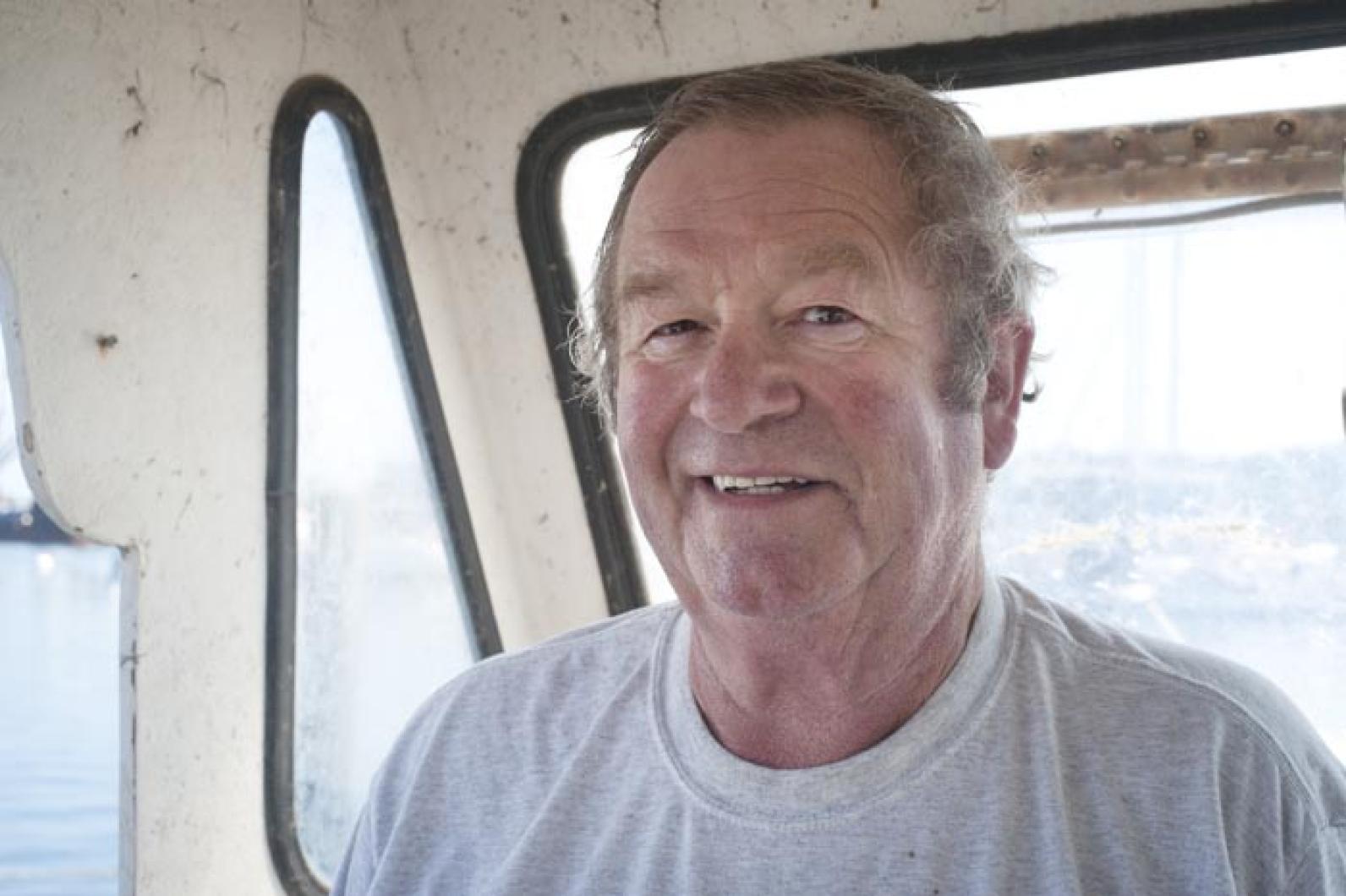M. Emmett Carroll Jr. has seen change on the waterfront, from the days when lobsters were bountiful to now when they seem scarce. He has kept his faith by dancing with new ideas, shifting his attention to raising oysters. He runs Menemsha Oysters, pretty much a one-man aquaculture operation which involves raising and harvesting some of the Island’s tastiest oysters.
Mr. Carroll, 67, begins most mornings going out in his 32-foot lobsterboat, Kathie C., and checking on his oysters, which are growing beneath the surface in Menemsha Pond. On this morning, the pond is almost as flat as a piece of glass. The sun is high over Chilmark’s hills. A fly-fisherman on a powerboat is casting for stripers over a shallow sand bar. It is solo work, but Mr. Carroll’s pursuits on the water include many people.
Mr. Carroll was born and raised here. His first career was building houses for his uncle, Herbert Hancock. “I worked for him, since I was 11 years old. I think I built 100 houses,” Mr. Carroll said. In 1971, he bought Menemsha Texaco. He still works there, but his son Marshall runs it now; Emmett gets no discount on his coffee.
“Herb talked me into lobstering,” he said. That was in the 1990s, when it was a profitable and productive fishery. In those days he motored out into Vineyard Sound and fished the waters off the north shore down to off Gay Head. It was a time of great success. More lobsters were landed by local lobstermen than came by ferries into Vineyard Haven and Oak Bluffs. Mr. Carroll got so good at it, he was brought in as a delegate for the Massachusetts Lobstermen’s Association. Today he is on the executive committee and his expertise on lobstering and fishing is a valuable resource. Mr. Carroll also long has been involved in a quiet way helping the town politically, trying to keep fishing and shellfishing vibrant here. He has been an advocate for active measures to cultivate the bay scallops and oysters in the pond.
Mr. Carroll has seen his livelihood change and wants to do something about it.
As lobstering got more difficult, Mr. Carroll started looking at new ways to make a living on his left-hand-sided boat by reinventing himself and adapting. In 2001 and 2002, he participated in an aquaculture project.
“I thought I would be a trailblazer for the kids coming along,” said Mr. Carroll, who tried playing with oysters.
Mr. Carroll joined with 10 other lobster fishermen in the region on an experiment administered by the Woods Hole Sea Grant and the Cape Cod Cooperative Extension Service, to raise oysters in lobster pots. Mr. Carroll inserted oysters into each of the 10 modified lobster pots that were given him.
Bricks and small cement blocks are usually used to ballast lobster pots. The ingenious idea here was to have the fishermen substitute young oysters for the bricks. So every time Mr. Carroll hauled any one of those pots, he could check for lobsters and note the health of the oysters.
The technique worked well. Mr. Carroll said he kept track of the growth rates and discovered that the oysters in his lobster pots in Menemsha Pond grew just as well, if not better, than those he put into the deeper Vineyard Sound.
Were it not for the decline in lobsters in local waters, Mr. Carroll said he might still be going with the idea, but on a larger scale.
Around this time he enrolled in an aquaculture course at Massachusetts Maritime Academy. “I learned what I didn’t know,” he said.
With help from the Martha’s Vineyard Shellfish Group and the ingenuity of other oyster aquaculture fishermen, mostly in Edgartown, Mr. Carroll made an educated shift to raising oysters in a quiet way in Menemsha Pond. The trips were a lot shorter and the fuel savings were considerable. He also bought a truck with refrigeration so he could make personal deliveries of his product to the mainland, to the local stores and restaurants and to any friend in need of fresh oysters.
It is hard to tell where Mr. Carroll’s grant is located in the expansive 640-acre Menemsha Pond. He uses a couple of duck decoys to mark off his area. Beneath the surface, his cages sit on the bottom. The duck decoys are perfect for a summer residential community more familiar with seeing birds adrift on the pond than lots of lobster pot buoys. Following a trawl line technique he learned from lobstering, he strings his oyster cages together with one line on the bottom. So he might have quite a few cages connected to just one floating buoy. It is a far less visible system than the one-buoy-to-one-cage system that seems to proliferate in other places.
After learning from his mistakes and the mistakes of others, Mr. Carroll said he thinks he has a pretty good working system. His bottom grant allows him to have 150 cages and he is able to keep himself busy and the income rolling in year-round. Last winter, he shipped his oysters almost weekly to the mainland.
Prior to raising and marketing oysters, Mr. Carroll said he didn’t eat oysters. Now he eats them all the time; it is an acquired taste.
Mr. Carroll said he is struck by the amount of sealife that takes residence in any one of his oyster cages. Amid his gear, he has found lobsters taking up residence, along with juvenile squeteague and plenty of small bait fish.
Each oyster cage is slightly smaller than a four-feet square and has an interior not unlike drawers in a cabinet. Plastic mesh bags are in each drawer. And each flat bag is loaded with oysters of similar age. It takes 2 1/2 years to raise an oyster to harvestable size.
Mr. Carroll has learned plenty by watching other oyster fishermen and experimenting on his own. For instance, there is more than one way to clean the outside of an oyster to make it more palatable.
“I tried power washing, I tried [putting the oysters through] a tumbler,” he said. But what works is simpler: He lets the cage sit overnight in the open air. The air kills all the algae growth on the outside of the oysters and the growth on the cages. The next day, he washes with a pressurized saltwater hose.
Mr. Carroll said he gets shoreside help culling his product and readying it for market from Henry “Hutch” Kirwin. As busy as Menemsha gets in the summer, with boats coming and going, and fishermen walking back and forth along the dock, Mr. Carroll has maintained a quiet, lone but not lonely existence. His colleagues say they wish they could have the job Mr. Carroll has.
Out on the water, when he shuts off his engine, his neighborhood is not entirely quiet. There are gulls and terns going about their usual business all around him. And that suits him just fine.
Mr. Carroll’s oysters are available regularly at the Chilmark Tavern. He sells to Stanley Larsen at Menemsha Fish Market and to Louis Larsen at the Net Result Fish Market, along with other places.






Comments
Comment policy »